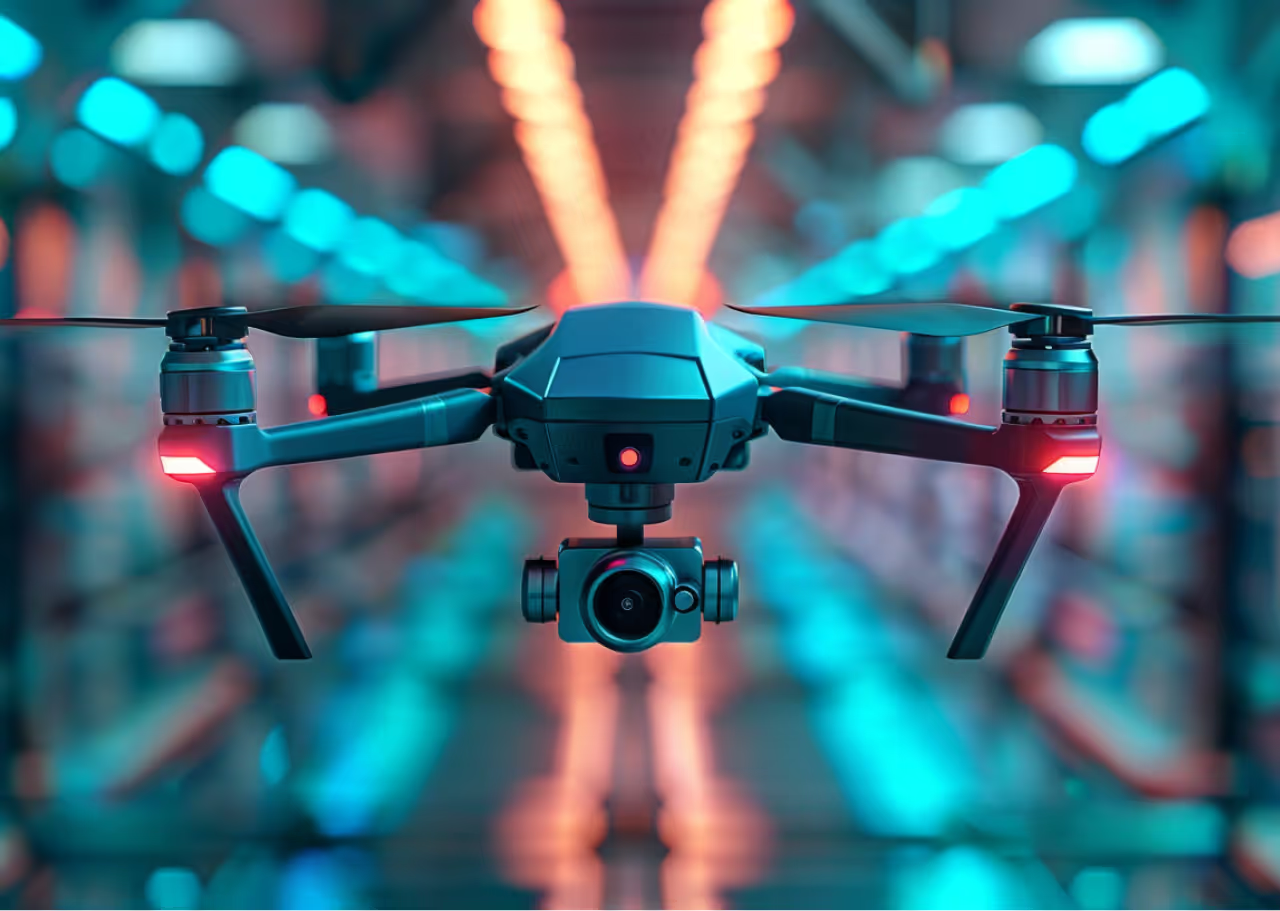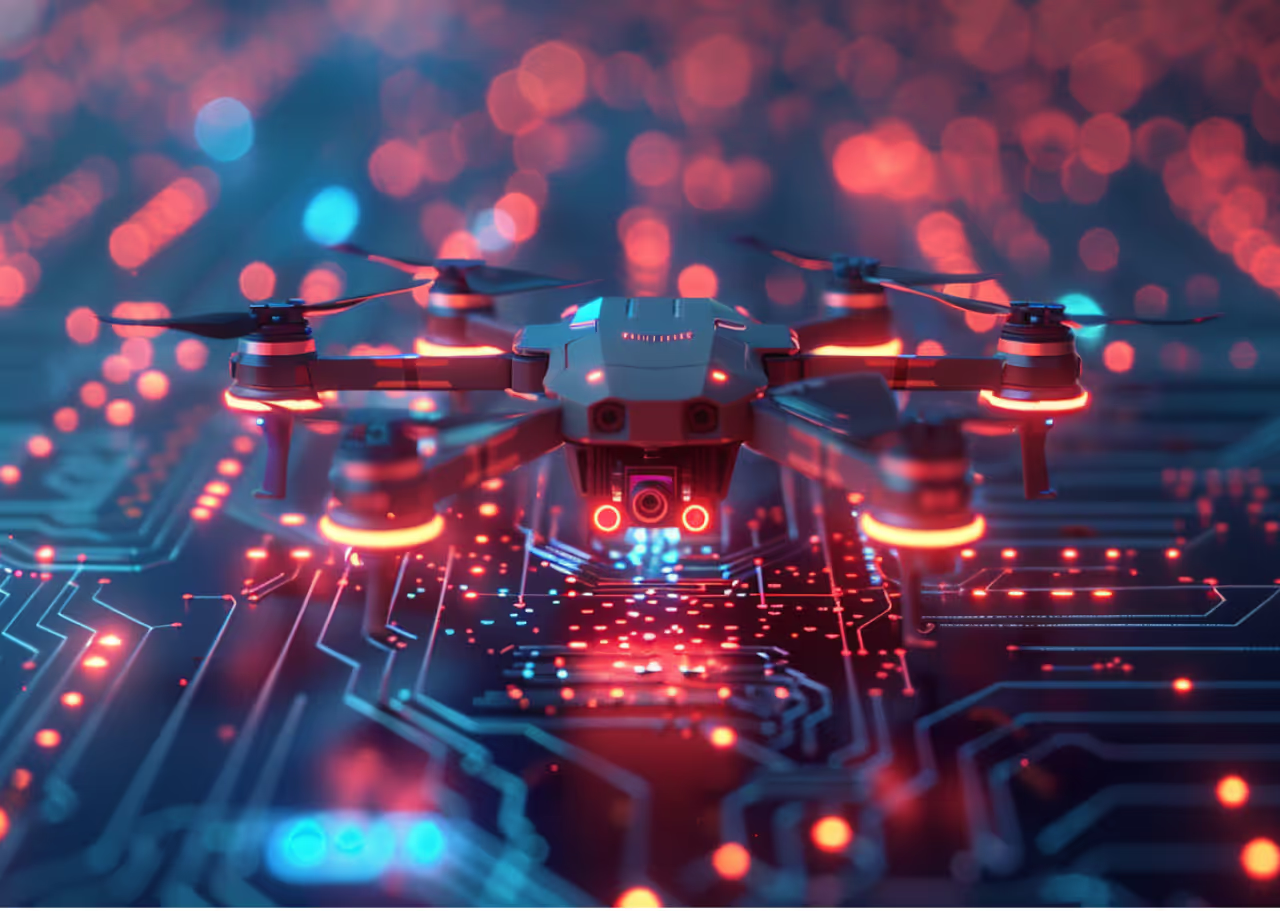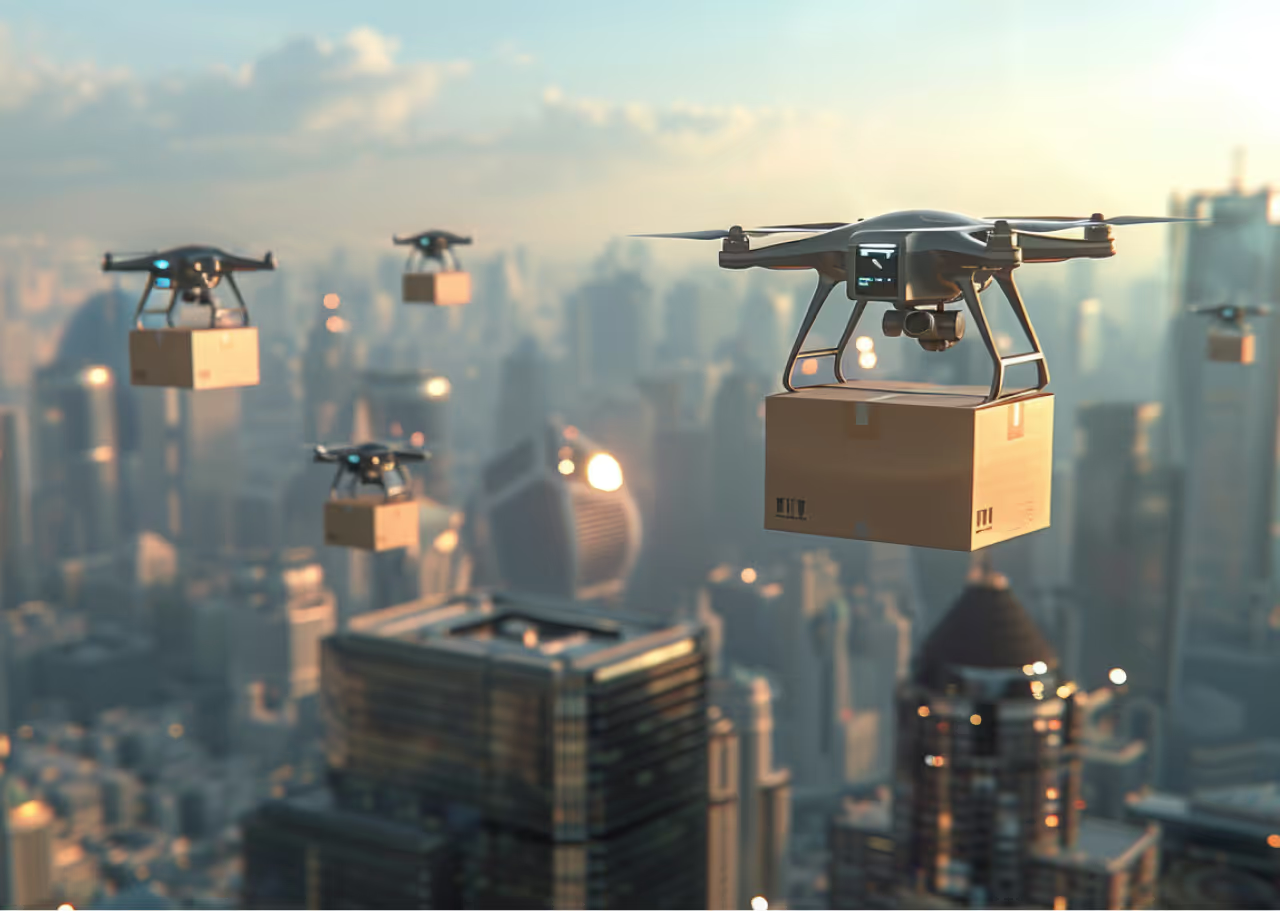Adversaries hijack drones, spoof GPS coordinates, and intercept sensitive data. Standard encryption cannot protect your operations from these active threats. Drone Communications delivers quantum-safe end-to-end protection for command signals, telemetry, and video across your entire infrastructure.
Remote control makes drones vulnerable to hijacking and data theft. Weak encryption and poor key generation expose operations to compromise. Adversaries exploit these vulnerabilities to steal data, manipulate commands, and take control of UAVs.
GPS spoofing and drone hijacking
Adversaries feed false GPS coordinates to take control of drones. Hijacked UAVs become weapons against your operations or assets. Security researchers have demonstrated how one compromised drone hijacks others, creating hostile swarms.
Quantum-vulnerable encryption standards
RSA and Elliptic Curve Cryptography (ECC) protect most commercial drones today. Quantum computers these encryption standards. Adversaries can decrypt intercepted drone communications once quantum computing matures.
Data interception and surveillance
Unencrypted communication channels expose video, telemetry, and flight paths to interception. Adversaries capture sensitive footage and operational data in real time. Your surveillance operations become their intelligence source.
Weak key generation in drone systems
Drone computers cannot truly generate secure encryption keys. Predictable keys enable adversaries to break encryption and compromise communications.
Drone Communications secures command signals, telemetry feeds, and video streams with Post Quantum Cryptography (PQC). Hardware-based security eliminates vulnerabilities in software-only solutions. Protect operations from hijacking, interception, and quantum threats.
Quantum-safe cryptography
CRYSTALS-Kyber (ML-KEM, NIST FIPS 203) replaces quantum-vulnerable RSA and ECC algorithms. Post-quantum algorithms resist attacks from classical and quantum computers. AES-256-GCM protects all data with authenticated encryption.
Hardware-based security foundation
Quantum Random Number Generator (QRNG) creates truly unpredictable encryption keys. Tamper detection alerts operators to physical attacks preventing supply chain compromises. Secure boot ensures only verified firmware runs on your systems.
Military-grade performance at scale
Achieve 1 Gbps line-rate encryption with sub-millisecond latency. High-speed processing supports live video, telemetry, and command without delays. Real-time operations maintain speed while gaining unbreakable security.
Multi-standard compliance readiness
NIST FIPS 203 ML-KEM and FIPS 204 ML-DSA meet federal requirements for UAV deployments. FIPS 140-3 Level 2 key storage satisfies defense contractor security mandates. QRNG follows NIST SP 800-90B entropy validation standards.
Low power design for extended operations
Operates at 3.3V consuming less than 800mA during active encryption. Deep sleep mode uses less than 50mA to conserve battery. Adaptive power scaling adjusts consumption based on cryptographic workload.
Protocol-agnostic integration flexibility
Supports MAVLink v2, Data Distribution Service (DDS), and custom protocols. Multiple interfaces include SPI, I2C, UART, USB, and GPIO. Firmware APIs available in C, C++, and Python.
Defense operations, critical infrastructure monitoring, and commercial inspections require secure drone communications. Drone Communications adapts to sector-specific security requirements and compliance mandates. Quantum-safe encryption protects operations where compromise means catastrophic consequences.
Secure UAV communications protect border patrol and perimeter security operations from adversary interception. Quantum-safe encryption prevents GPS spoofing attacks that redirect surveillance drones away from critical areas. Real-time tamper detection alerts operators to attempted hijacking of defense UAVs during sensitive missions.
CNSA 2.0 compliant encryption meets federal requirements for protecting classified communications and intelligence data. ML-DSA Level 5 authentication ensures only authorized personnel control defense drones. Hardware root-of-trust prevents supply chain attacks on UAVs deployed in sensitive environments.
Connect distributed military installations with quantum-safe channels for coordinated drone operations and intelligence sharing. Secure command networks enable tactical teams to control UAV assets without exposing mission plans. Beyond Visual Line of Sight (BVLOS) operations gain security for remote autonomous missions.

Protect control systems from cyber attacks during aerial infrastructure inspections and monitoring. Secure drone communications enable remote monitoring of power grids, pipelines, and industrial facilities. Quantum-safe encryption prevents adversaries from intercepting operational data or manipulating drone surveillance.
Secure aerial inspections of energy infrastructure without exposing vulnerabilities to adversaries monitoring communications. Protect transmission line surveys, solar farm monitoring, and wind turbine inspections from data theft. Enable predictive maintenance programs with confidence in data integrity and operational security.
Coordinate emergency response teams with quantum-safe drone communications during infrastructure incidents and disasters. Secure real-time video feeds during search and rescue operations protect operational details from interception. Enable rapid damage assessment after natural disasters without compromising response coordination.

Protect proprietary inspection data and survey results from competitors intercepting drone communications. Secure construction site monitoring, facility inspections, and asset tracking prevent industrial espionage. Enable commercial BVLOS operations with regulatory-compliant security for autonomous drone fleets.
Secure aerial crop monitoring, yield analysis, and precision agriculture data from unauthorized access. Protect investment in agricultural technology and farming strategies from competitors intercepting UAV data. Enable large-scale farm monitoring with confidence in data ownership and operational privacy.
Protect autonomous delivery drone communications from hijacking attempts and route interception during operations. Secure package tracking, delivery confirmation, and fleet coordination across distributed logistics networks. Enable urban air mobility and commercial delivery with quantum-safe protection for customer data.

Defense organizations and critical infrastructure operators trust Drone Communications for mission-critical operations. Real deployments validate quantum-safe technology under demanding operational conditions. Independent certifications prove security standards for federal and enterprise requirements.
Defense deployment validation
Deployed across Indian Armed Forces for border surveillance and BVLOS missions. Trusted by defense research laboratories for prototype integration and compliance testing. Battle-tested in strategic defense environments protecting classified communications.
NIST post-quantum standards
ML-KEM (NIST FIPS 203) and ML-DSA (NIST FIPS 204) approved algorithms. Post-quantum cryptography standards validated by National Institute of Standards and Technology. Federal agencies adopt NIST-approved algorithms for quantum resistance.
CNSA 2.0 compliance certified
Commercial National Security Algorithm Suite 2.0 certified for federal deployment. Meets requirements for protecting classified communications and sensitive government operations. Approved for defense contractors and agencies handling national security information.
Global trust across sectors
Deployed across defense, banking, automotive, telecommunications, and healthcare sectors globally. Trusted in India, Middle East, Europe, and United States for sensitive operations. Fortune 500 companies and government agencies rely on quantum-safe protection.
Traditional drone encryption uses quantum-vulnerable algorithms that sophisticated adversaries exploit. Competitors address single security aspects without comprehensive protection. Drone Communications delivers complete quantum-safe architecture from hardware to cloud.
Quantum-safe drone communication uses post-quantum cryptographic algorithms like CRYSTALS-Kyber and ML-KEM to protect UAV operations. These lattice-based algorithms resist attacks from both classical and quantum computers. Protection extends to command signals, telemetry data, and video streams across all communication channels.
Hardware root-of-trust ensures only verified firmware runs on the encryption module. Quantum Random Number Generator creates unpredictable keys that adversaries cannot reproduce or predict. Real-time tamper detection alerts operators to physical attacks before operations are compromised.
Secure OTA updates download new encryption algorithms to deployed drones without physical access. AES-256-GCM signed updates include rollback protection preventing downgrade to vulnerable algorithms. This enables response to emerging threats and compliance with evolving security standards.
No. Adaptive power scaling adjusts consumption based on workload while maintaining full encryption strength. Hardware acceleration enables 1 Gbps encryption with sub-millisecond latency using minimal power. Deep sleep mode conserves battery without compromising security when encryption is not active.
Tamper detection triggers data erasure protocols to protect encryption keys and operational data. Hardware security module prevents extraction of cryptographic material even with physical access. Unique keys per drone limit exposure to single-device compromise without affecting fleet security.
Yes. Drone Communications works with industry-standard flight controllers running MAVLink v2 and custom protocols. Multiple interfaces including SPI, UART, USB, and GPIO enable integration. Firmware APIs in C, C++, and Python support various development environments.
Drone Communications provides end-to-end quantum-safe protection from drone to cloud with hardware-based security. Traditional solutions use quantum-vulnerable RSA or ECC algorithms with software-only key generation. Our platform includes QRNG for unpredictable keys, tamper detection, and crypto agility through OTA updates.
NIST FIPS 203 (ML-KEM) and FIPS 204 (ML-DSA) for post-quantum cryptography. FIPS 140-3 Level 2 for key storage and cryptographic module security. CNSA 2.0 certified for federal agencies and defense contractors. QRNG follows NIST SP 800-90B entropy validation.
Only commands from authorized ground stations can control your drones. ML-DSA certificates authenticate every command before drones respond to GPS coordinates. Hardware tamper detection alerts operators to manipulation attempts before drones respond to false coordinates.
Defense surveillance and border patrol operations requiring classified data protection. Critical infrastructure inspections where data theft creates security vulnerabilities. Commercial BVLOS operations needing regulatory-compliant security for autonomous flights. Any mission where drone hijacking or data interception has catastrophic consequences.